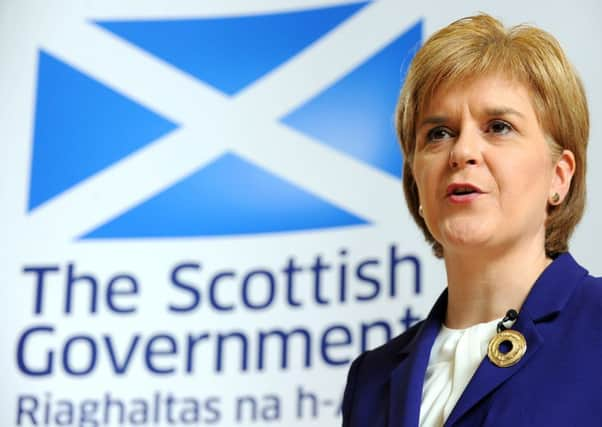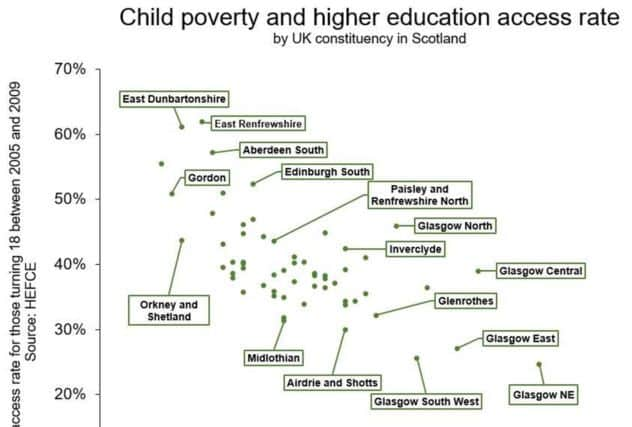Is Scotland’s education system failing the poor?


In a speech to education leaders in August, the First Minister said: “Let me be clear – I want to be judged on this. If you are not, as First Minister, prepared to put your neck on the line on the education of our young people then what are you prepared to. It really matters.”
Despite rising standards across schools in Scotland, students in more affluent areas are twice as likely as those in poorer areas to get at least one Higher.
Advertisement
Hide AdAdvertisement
Hide AdWhile the proportion of university students from non-professional backgrounds in Scotland has risen since 2011 by just 0.2 percentage points to 26.8 per cent, in England it has risen from 30.9 to 33.1 per cent, The Economist reported.


Scottish students pay no tuition fees at universities north of the Border, while English students can pay up to £9,000 per year.
UCAS data revealed 9.7 per cent of those accepted to university in Scotland this year were from the most disadvantaged areas compared to 17 per cent in England, 13.9 per cent in Northern Ireland and 15.5 per cent in Wales.
The Scottish Conservatives said this made “Scotland by far the worst-performing part of the UK.”
A Scottish Government spokeswoman told The Scotsman: “The reality is that young people from deprived areas in Scotland are now more likely to participate in Higher Education by the age of 30 than they were in 2006-07 (up from 35 per cent in 2006-07 to 42 per cent in 2013-14).”
“Moreover, our commitment to free tuition; the prospect of the lowest average debt and the best graduate prospects in the UK saw a record number of Scots accepted to study at Scottish universities in 2015-16, an increase of 2 per cent on last year.”
Thomas Forth, an associate of the Leeds branch of the Open Data Institute, said devolution made comparing nations within the UK difficult.
The vast majority of Scottish pupils sit Highers, not A-levels, and many enter universities aged 17, not 18 as in England.
Advertisement
Hide AdAdvertisement
Hide Ad“Loud voices in London think Scotland’s higher education system is failing its poor. Loud voices in Edinburgh insist that everything’s great. From Leeds, the exact midpoint of the two cities, my look at the data seems to show something in between,” he said.
“Scotland’s performance only looks poor if you discount people who access higher education outside of UCAS’s university admission service. When you include these young people Scotland seems to have improved significantly in the past decade and currently does better than most English regions.
“Comparing different education systems is a challenge made more difficult by the poor availability of open data across the UK. Improving the quality and availability of that data will go further to improving education across the UK than making accusations and counter-accusations on the basis of poor information.”
The Scottish Government faced widespread criticism from opposition parties in April when the latest Scottish Survey of Literacy and Numeracy, which examines performance in school years P4, P7 and S2, was published.
It found 78 per cent of P4 pupils performed well or very well in reading in 2014, compared with 83 per cent in 2012.
A total of 88 per cent of P7 were performing well or very well in reading 2014, down from 90 per cent in 2012.
The survey also found pupils from the least deprived areas performed better in all areas of literacy, compared to those from the most deprived areas.
The First Minister plans to introduce standardised testing for primary pupils and has pledged dozens of new schools will benefit from a £100 million government fund aimed at driving up attainment levels.
Advertisement
Hide AdAdvertisement
Hide AdScottish Labour leader Kezia Dugdale has previously pledged to put the education gap between rich and poor areas at the heart of next year’s Holyrood election campaign.
Most of Scotland’s local authorities use some form of assessment to judge pupils’ progress, but different systems means comparisons are difficult.
Currently 30 out of 32 councils use standardised assessment for primary and lower secondary pupils.
A Scottish Government spokeswoman continued: “We recognise there is more to do to engage all children and young people in education and improve literacy. That’s why the £100 million Scottish Attainment Challenge, the Read, Write, Count campaign and Access to Education funding are all designed to drive up standards so that school leavers can make the choice of whether to pursue education, rather than feel it isn’t an option for them.
“We have been very clear that we want every child, whatever their background, to have an equal chance of benefitting from higher education if that is their choice and the range of experts on our Commission on Widening Access are looking at what more can be done to remove the barriers that often stand in the way of gifted pupils from deprived communities.”